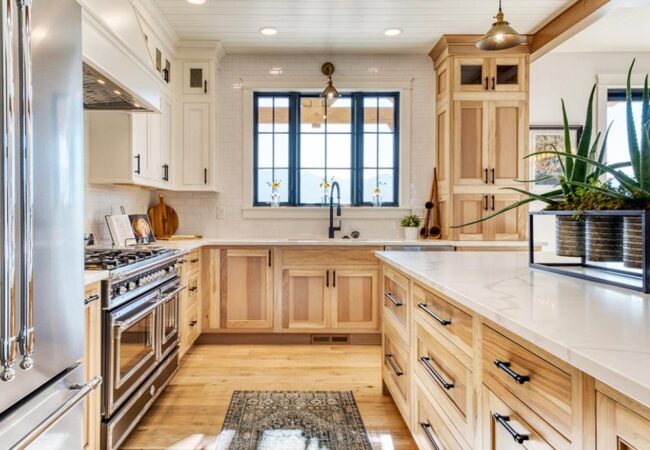
A kitchen renovation is one of the most impactful home improvement projects, offering an opportunity to enhance functionality, style, and efficiency. However, modern renovations should go beyond aesthetics and convenience. Sustainability is at the forefront of home improvement trends, allowing homeowners to reduce environmental impact while creating a healthier living space.
From choosing eco-friendly materials to incorporating energy-efficient solutions, a sustainable kitchen transformation is both a smart investment and a responsible choice. Whether you’re starting from scratch or making small eco-conscious upgrades, these strategies will help you design a green kitchen that aligns with modern sustainability principles.
1. Why Choose a Sustainable Kitchen Renovation?
Traditional renovation methods often involve materials and practices that generate excessive waste, consume significant energy, and contribute to indoor air pollution. A sustainable kitchen remodel not only minimizes environmental harm but also offers several long-term benefits:
- Lower energy bills – Energy-efficient lighting, appliances, and insulation reduce electricity and gas consumption.
- Improved indoor air quality – Low-VOC paints, non-toxic finishes, and sustainable cabinetry create a healthier space.
- Waste reduction – Reclaimed wood, recycled materials, and responsible disposal methods prevent unnecessary landfill contributions.
- Increased home value – Energy-efficient and environmentally friendly homes are increasingly attractive to buyers.
2. Choosing Eco-Friendly Materials for Kitchen Renovations
Sustainable Countertop Options
Kitchen countertops play a significant role in design and sustainability. Instead of conventional quartz or granite, consider these greener alternatives:
- Recycled glass – Made from post-consumer glass, these countertops offer a unique and durable surface.
- Bamboo – A renewable resource that grows rapidly and provides a sleek, modern aesthetic.
- Reclaimed wood – Adds warmth and character while reducing the demand for newly harvested lumber.
- Recycled paper composite – An innovative material combining post-consumer paper and non-toxic resins, offering durability and resistance to stains.
Environmentally Friendly Flooring Choices
Flooring is another major component of a kitchen renovation. Opt for sustainable options such as:
- Cork – Harvested from the bark of cork oak trees without cutting them down, making it a renewable and comfortable flooring option.
- Reclaimed hardwood – Salvaged wood from older buildings provides a timeless, rustic appeal without contributing to deforestation.
- Linoleum (not vinyl) – Made from natural materials like linseed oil and jute, linoleum is biodegradable and durable.
Sustainable Cabinetry and Woodwork
Traditional cabinetry materials often contain formaldehyde and other harmful chemicals. Instead, choose:
- Reclaimed wood or FSC-certified wood – The Forest Stewardship Council (FSC) certification ensures that wood is harvested responsibly.
- Bamboo cabinetry – A sustainable alternative with a modern, sleek look.
- Low-VOC finishes – Opt for water-based, low-VOC stains and sealants to minimize indoor air pollutants.
3. Energy-Saving Kitchen Appliances and Fixtures
Upgrading to energy-efficient appliances is one of the most effective ways to reduce energy consumption. Look for:
- ENERGY STAR® appliances – These certified products use significantly less energy and water than standard models.
- Induction cooktops – More energy-efficient than gas and traditional electric stoves, induction cooking heats faster and reduces wasted heat.
- Smart refrigerators – Features such as energy-efficient cooling, temperature control, and reduced food waste make smart fridges a sustainable choice.
- Convection ovens – These use less energy than traditional ovens by circulating hot air more efficiently.
4. Optimizing Natural Light and Energy-Efficient Lighting
Lighting plays a key role in both sustainability and ambiance. Maximize natural light and choose energy-efficient solutions such as:
- LED lighting – Uses up to 80% less energy than incandescent bulbs and lasts significantly longer.
- Motion sensor or dimmable lights – Reduces unnecessary energy consumption.
- Skylights or larger windows – Harnessing natural light reduces the need for artificial lighting during the day.
5. Water-Saving Fixtures for a Greener Kitchen
Water conservation is an essential component of an eco-friendly kitchen. Consider installing:
- Low-flow faucets – Reduces water usage without compromising performance.
- Aerators – Attachments that mix air with water to maintain pressure while using less water.
- Energy-efficient dishwashers – Uses less water and energy compared to handwashing.
6. Reducing Waste with Sustainable Practices
Kitchen renovations can generate significant waste, but adopting responsible disposal methods makes a difference:
- Donate old cabinetry and fixtures – Instead of discarding materials, donate usable items to local charities or salvage organizations.
- Repurpose materials – Transform old wood, metal, or glass into new elements within your kitchen design.
- Recycle construction debris – Work with contractors who practice responsible recycling.
7. Smart Design for Longevity and Efficiency
A truly sustainable kitchen isn’t just about materials—it’s also about designing a space that lasts. Focus on:
- Timeless design – Avoid overly trendy elements that may go out of style quickly, leading to unnecessary renovations in the future.
- Multi-functional spaces – Well-planned layouts improve efficiency and reduce the need for future modifications.
- Durable materials – High-quality materials last longer, reducing the need for replacements.
If you’re considering kitchen renovations in Vaughan, integrating these sustainable principles will help you create an energy-efficient and eco-friendly space without compromising on style or functionality.
8. Government Incentives and Rebates for Energy Efficiency
In Canada, homeowners who invest in sustainable renovations may be eligible for rebates and incentives:
- Canada Greener Homes Grant – Provides financial support for energy-efficient home upgrades, including kitchen renovations. (Government of Canada for details)
- Ontario’s Save on Energy program – Offers rebates for energy-efficient appliances and lighting.
- Enbridge Home Efficiency Rebate – Provides financial incentives for energy-efficient home improvements. (Enbridge Gas)
Taking advantage of these programs can offset renovation costs while making eco-friendly upgrades more accessible.
Final Thoughts
A sustainable kitchen renovation is more than an eco-conscious decision—it’s an investment in efficiency, cost savings, and long-term value. By choosing green materials, energy-efficient appliances, and water-saving solutions, homeowners can create a modern, environmentally friendly kitchen that aligns with sustainability goals.
With increasing awareness of climate change and energy conservation, eco-friendly renovations are no longer a niche trend but a forward-thinking approach to home improvement. Whether you’re making small changes or undertaking a full remodel, integrating sustainable elements into your kitchen design will contribute to a greener future while enhancing the beauty and functionality of your home.
